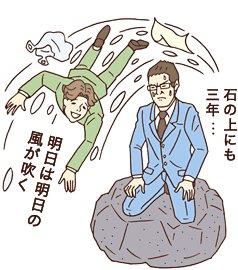 The Japanese have a saying ishi no ue ni mo san nen 石の上にも三年. Roughly translated, it means “sit patiently for three years, even on a rock.” If you’re persistent and/or patient enough when undertaking something, in the end, it will have been worth it and you’ll be rewarded with success.
The Japanese have a saying ishi no ue ni mo san nen 石の上にも三年. Roughly translated, it means “sit patiently for three years, even on a rock.” If you’re persistent and/or patient enough when undertaking something, in the end, it will have been worth it and you’ll be rewarded with success.
The near opposite phrase is ashita wa ashita no kaze ga fuku 明日は明日の風が吹く or “tomorrow, tomorrow’s wind will blow.” This basically means whatever is going to happen will happen.
These two ways of thinking are often in contention when it comes to sustainability. On one hand – the sit on a rock 3 years group – are the extremists and the climate change deniers. They are the environmentalists who resort to wild stunts and gimmicks (sleeping in trees) on the one hand and the staunch climate change deniers who create media storms around email chains and make Al Gore igloos on the other. They stir up debate and generate awareness. This group of über environmentalists and über naysayers are willing to sit on the rock no matter what and grit it out until their specific goal is achieved: legislation is passed, technology is invented, debate ceases, legislation is reversed etc.
The other way of thinking – the let tomorrow’s wind blow group – includes people who are content to float along with the breeze, going what ever direction it takes them. If climate change is happening, we’ll deal with it. If it’s not, we’ll mange as we have. This group senses there may be something wrong with the imbalances in our economic, environmental, and societal interactions but is content to let things happen at their own course without thinking about the consequences.
How is it possible to get anything done with such different mentalities and such a large divide among the two groups? As is often the case, some combination of the two is probably the most effective and pragmatic. We place the debate in terms of extremes, but these are the ends on the bell shaped curve. The loudest ones get heard but it’s really a continuum where most people fall in the middle. The vast majority of Americans are probably somewhere in between the two extremes. They may have a leaning toward the fierce passion of either the rabble rousing environmentalists or the rabble rousing anti-environmentalists, but they aren’t willing to sit on a rock for three years supporting one of those stances. Likewise, they may be inclined to think that it all doesn’t matter anyway; that what will happen will happen and that we have other immediate day-to-day worries on which to focus. But in the end, most people are likely to sway between these extremes and fall in the middle. “What is using cloth grocery bags and upping the temperature of my air conditioner a degree or two really going to do? How big an impact will that have?” they’ll ask themselves. Yet they’ll often feel good about taking such measures, especially if they see some kind of more tangible results like fewer plastic bags around their neighborhood and a reduction in heating costs on their electricity bill.
This leads us to the philosophy behind this site. We’ve been sitting on a rock for 2.5 years as we work on the site. We are trying to portray a balanced approach to sustainability. Our sitting on the rock is not the extremist version but rather what we think is the most effective way forward in becoming a sustainable society: balance. There will always be those who will hurl paint at Japanese whaling ships, or, on the other side, vote only for those elected representatives who deny climate change. There will also always be groups of nihilistic/doesn’t matter/who cares people. But we think the majority resides in the middle. We are counting on this middle to be the fulcrum that, with small movements taken en masse, shifts us toward sustainability.

